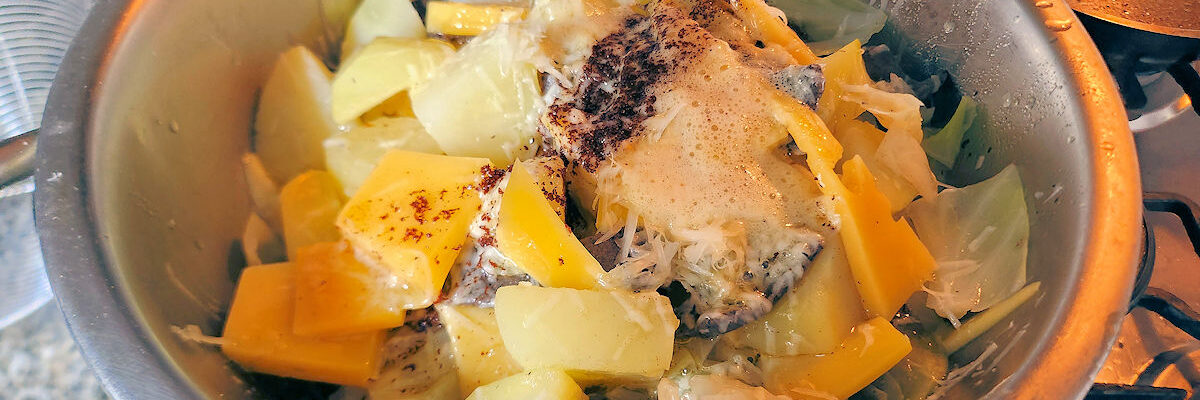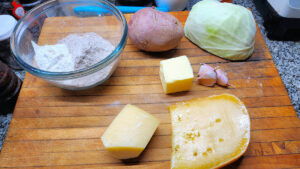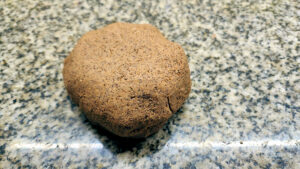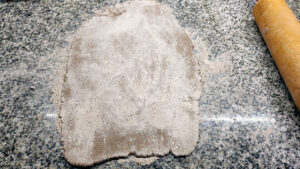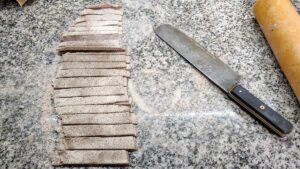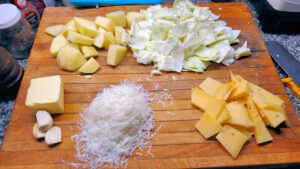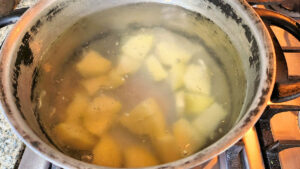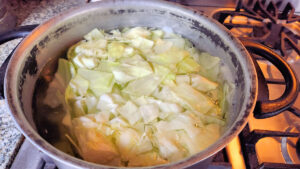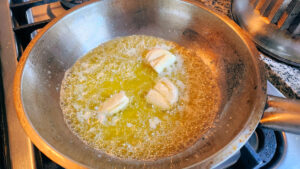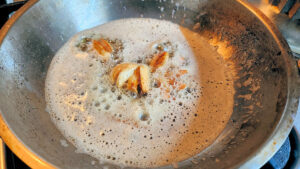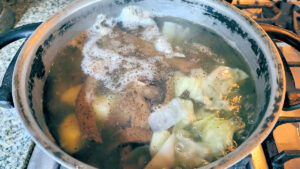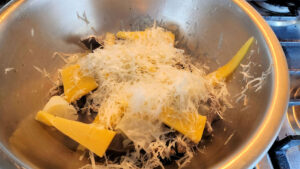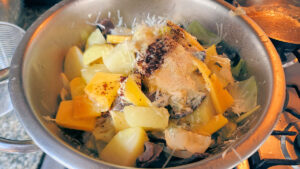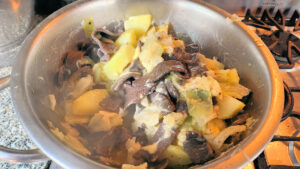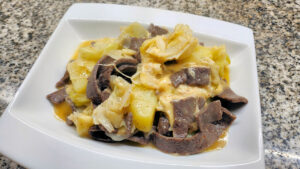I don’t remember who it was among my circle who asked about a recipe for Pizzoccheri alla Valtellinese, but as the last gasps of winter die out in Buenos Aires, it seemed time to slip this one in under the wire. There is some debate over the origin of the name pizzoccheri (pronounced “peetz-OHK-ehry”), some claiming it’s from the local Lombaridan dialect bizzo, meaning a mouthful, and others from piz, a bit. What there isn’t disagreement with is that this is one hearty pasta dish, laden with a huge amount of gooey cheese and slathered over with garlic butter.
As always, let’s get our mise-en-place ready. In a bowl I have a mix of buckwheat and wheat flour. There is some debate over whether it should be 75 or 80% buckwheat, but in that neighborhood – 3:1 or 4:1, I lean towards the former, it gives it just a touch more gluten to help it hold together (buckwheat doesn’t have gluten). I’m making this for two, so I used 3/4 cup and 1/4 cup, respectively. One medium potato, a wedge of cabbage roughly the same size. Maybe 3-4 tablespoons of butter, a couple of large garlic cloves, a wedge of fontina cheese (roughly 6 oz before removing the rind), and a small block of parmigiano.
Mix the flours together with just enough water to create a smooth dough. Keeping in mind that it has little gluten, there’s not a lot of kneading going on here. Just enough to get it to get it to a smooth, not sticky, ball. Given that there’s almost no gluten, you don’t even have to rest this pasta before moving on.
[Since someone’s likely to ask… can you make this with all buckwheat flour and make it gluten-free. Yes, I’m sure you can. You’ll need something to help it hold together a bit better than the buckwheat flour on its own would, and probably add some xanthan gum or arrowroot powder to the flour to give it a little elasticity, or, even though it’s not traditional to do so, maybe an egg. As to how much, you’ll need to experiment.]
Roll it out to about 3mm thickness, a little less than 1/8″. Use buckwheat flour to stop it from sticking. It’s going to feel different rolling it out from regular pasta because it doesn’t have any elasticity.
Cut it into strips roughly 3″ in length and maybe 3/4″ wide.
Peel and cut the potato into chunks about 3/4″ as well, and cut the cabbage to about the same size. Grate the parmigiano, and cut the fontina into pieces, well, about the same size as the vegetables, but thinner.
Get a pot of salted water on the stove and bring it to a boil. Add the potatoes, bring back to a boil, and simmer away for about 2 minutes.
Add the cabbage, return to a boil, and simmer for 10 minutes.
While this is simmering away, make your garlic brown butter – peel the cloves, crush them lightly, and add to a pan with the butter. Over low heat, and flipping the garlic now and again, cook this until the butter turns nut brown. Set aside but keep warm.
Back to our boiling pot, with the ten minutes up, add in the pasta. Bring back to a boil and cook for about 2-3 minutes, until the pasta is done.
Scoop out about a third of the pasta and veggies and put in a bowl. Top with about a third of the cheeses. Add a few grinds of pepper – how much is up to you – I like it a little extra peppery, so go with about a dozen grinds. Repeat this twice more to use up the rest, creating three layers.
Now that the pot is empty of all but the hot water, set the bowl over the pot, and leave for a couple of minutes. The added heat will help ensure that the cheese melts and gets nice and gooey.
Remove the garlic cloves from the browned butter and drizlle the butter all over the pasta. Gently mix it all together, making sure to get that cheese and butter distributed throughout.
And, serve.
That’s it. It’s a really simple pasta dish. I think from start to finish it took me only half an hour. There is a version of this where you layer the pasta into a baking dish rather than a bowl, top it with breadcrumbs, drizzle the garlic butter over that, and stick it under the broiler to brown. It’s, perhaps, prettier when it comes to the table, but as soon as you scoop it out onto your plate, you wouldn’t know the difference.
This is, as I intimated, a heavier, winter dish. I mean, potatoes, cabbage, and buckwheat noodles, lots of cheese and butter. It’s not the sort of pasta you’re going to eat on a daily basis, but might be a great one for after coming in from shoveling snow! It’s one that I make probably once a year, in chill weather. That seems to hit the spot.
